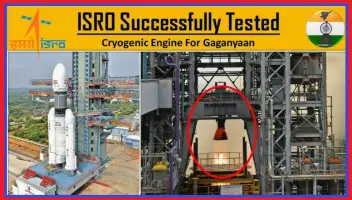🚀ISRO Achieves Breakthrough with Semi-Cryogenic Engine for Gaganyaan Mission
Table of Contents
ToggleIn a significant stride toward sending Indian astronauts into space, the Indian Space Research Organisation (ISRO) has successfully conducted a key test of its semi-cryogenic engine for the Gaganyaan mission. This crucial engine trial, held at the ISRO Propulsion Complex in Mahendragiri, Tamil Nadu, marks one of the most important technological milestones in India’s first human spaceflight program.
With this success, ISRO takes a giant leap closer to launching astronauts into low Earth orbit using indigenous propulsion technology.
🔬 What is a Semi-Cryogenic Engine?
A semi-cryogenic engine uses liquid oxygen (LOX) as the oxidizer and kerosene (RP-1) as the fuel — a highly efficient combination that provides higher thrust compared to traditional solid or earth-storable liquid engines.
For the Gaganyaan mission, this engine is being developed to power the future stages of India’s heavy-lift launch vehicles, offering better performance, reusability, and cost-efficiency.
The successful test validated:
Combustion stability
Structural integrity under pressure
Cryogenic handling and ignition sequences
“This is a game-changer for ISRO’s human spaceflight capabilities,” said an ISRO official after the test.
👨🚀 Importance for Gaganyaan Mission
The Gaganyaan mission, India’s flagship human spaceflight project, aims to send a crew of Indian astronauts (Vyomanauts) to space and bring them back safely. The mission, originally delayed due to the COVID-19 pandemic, is now gaining fresh momentum with this technological success.
The semi-cryogenic engine for Gaganyaan mission is expected to:
Deliver greater payload capacity
Support long-duration missions
Enable future crewed lunar missions
Lay the foundation for India’s space station plans by 2035
🌍 What’s Next for ISRO?
With this milestone cleared, ISRO will now:
Conduct long-duration engine firings
Integrate the engine with GSLV Mk-III (LVM3) architecture
Advance uncrewed Gaganyaan test flights in early 2026
Move toward full crewed mission expected around 2027
India has already trained four astronaut candidates in Russia and is also developing indigenous life support systems, crew modules, and mission control infrastructure for Gaganyaan.
🌟 Why This Matters Globally
India joins the elite club of nations — including the US, Russia, and China — that have developed or are developing semi-cryogenic propulsion systems for human spaceflight. This positions ISRO not just as a satellite launch leader but as a credible force in deep space exploration and human spaceflight programs.
✅ Conclusion: Fueling India’s Astronaut Dreams
The successful test of the semi-cryogenic engine for Gaganyaan mission is more than just a technical milestone — it’s a symbol of India’s growing self-reliance and ambition in space exploration. It shows the world that ISRO is preparing to not just launch satellites, but also launch dreams, possibilities, and people into space.
As countdown begins for India’s first human spaceflight, this engine will be the heart that powers the mission beyond the stratosphere.
❓ Frequently Asked Questions (FAQ)
1. What is the Gaganyaan mission?
The Gaganyaan mission is India’s first human spaceflight program led by ISRO, aimed at sending Indian astronauts (Vyomanauts) into low Earth orbit and bringing them back safely. It represents India’s entry into human space exploration.
2. What is a semi-cryogenic engine?
A semi-cryogenic engine uses liquid oxygen (LOX) as the oxidizer and refined kerosene (RP-1) as the fuel. This combination offers higher efficiency, greater thrust, and is more cost-effective compared to traditional fuel systems.
3. Why is the semi-cryogenic engine important for Gaganyaan?
The semi-cryogenic engine for Gaganyaan mission will power India’s heavy-lift launch vehicles, enabling them to carry the astronaut crew module, life support systems, and other equipment safely into orbit.
4. Where was the engine test conducted?
The successful test of the semi-cryogenic engine was conducted at the ISRO Propulsion Complex (IPRC) in Mahendragiri, Tamil Nadu.
5. What did the test validate?
The test validated:
Combustion stability
Structural performance
Cryogenic fuel handling
Engine start-up and shutdown reliability
6. How does this engine differ from ISRO’s current engines?
ISRO currently uses cryogenic and solid/liquid fuel engines. The semi-cryogenic engine bridges these technologies by offering higher thrust, reusability, and better fuel efficiency, making it ideal for human-rated missions.
7. Is this engine developed fully in India?
Yes. The semi-cryogenic engine is indigenously developed by ISRO scientists and engineers, showcasing India’s self-reliance in advanced space propulsion systems.
8. When is the Gaganyaan mission expected to launch?
ISRO plans to conduct uncrewed test flights in 2026, followed by a crewed mission around 2027, depending on further technical clearances and safety evaluations.
9. How many astronauts will go on the first Gaganyaan mission?
The first crewed mission will carry 3 Indian astronauts into low Earth orbit, where they are expected to spend up to 7 days in space before returning to Earth.
10. What does this mean for India’s space ambitions?
This milestone positions India among the elite nations capable of independent human spaceflight, and lays the groundwork for future plans like:
India’s own space station by 2035
Deep space missions
International space collaborations




